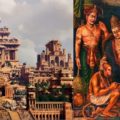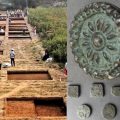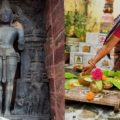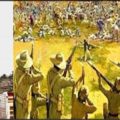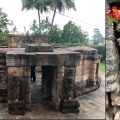Early History of Odisha: Connection of Kharavela with Nanda of Magadh
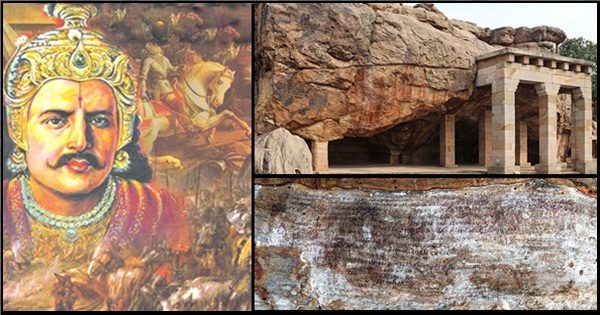
According to Purāṇas, Queen Sudeshna bore five sons named Aṅga, Vaṅga, Kaliṅga, Pundra and Suhma to her husband the Ānava King Bali begotten on her by Rishi Dīrghatamas. Kaliṅga became the king of the region of modern Orissa during the Rigvedic period. Thus, the kingdom of King Kaliṅga came to be known as Kaliṅga janapada. The earliest reference to Kaliṅga janapada is found in Aitareya Brāhmaṇa.
The earliest kings of Kaliṅga belonged to the Anu branch of the lunar dynasty. Manu’s son Sudyumna had three sons, Utkala, Gaya and Haritāśva or Vinatāśva. King Utkala might have reigned over northern Orissa. Rāmāyaṇa refers to Kaliṅga janapada. Mahābhārata also mentions Kaliṅga janapada and its capital Rājapura. Duryodhana eloped with the daughter of Kaliṅga King Chitrāṅgada of Rājapura and married her. Kaliṅga King Śrutāyudha or Śrutāyuṣa participated in the Mahābhārata war in support Kauravas but got killed by Bhima.
The Rock edict no. 13 of King Aśoka indicates that Kaliṅga was conquered by King Devānāmpriya Priyadarśi. Purāṇas tell us that total 32 kings of Kaliṅga reigned from the Mahābhārata era to the time of Mahāpadma Nanda. Mahāmeghavāhana kings of the Aira dynasty reigned over Kaliṅga starting from the 13th century BCE. Kharavela was the most celebrated King of the Mahāmeghavāhanas.
The Date of King Kharavela
Khāravela was the earliest known King of Kaliṅga from the epigraphic sources. He was the author of the famous Hathigumpha inscription. Khāravela invokes Namokāra mantra of Jainism (Namo Arihantanam Namo sava-Siddhanam) in the beginning of the inscription.
Evidently, Khāravela was the follower of Jainism. The inscription refers to Khāravela as Aira, Mahāmeghavāhana, Chetarāja-Vaṁśa- Vardhana and Kaliṅgādhipati. Aira means the progeny of mother Ira. Thus, Khāravela belonged to the Mahāmeghavāhana branch of the Aira dynasty. It is also indicated that King Khāravela was born in the lineage of King Chetarāja.
Historians generally date Khāravela around 170-150 BCE. Some scholars have also speculated that Khāravela mentions the name of Yavana King Dimiti or Demetrius I (200-180 BCE) and therefore, he must be dated around 200-180 BCE. It may be noted that the Hathigumpha inscription clearly mentions the date as 103 years from the reign of King Nandarāja but historians have either conveniently ignored or distorted this fact in fixing the date of Kharavela.
Some historians suggest that Nandarāja must be identified as Aśoka and the date of the Hathigumpha inscription must be around 154 BCE considering 103 years elapsed from the date of the conquest of Kaliṅga by Aśoka (257 BCE). Some scholars have also read 103 years as 300 years and fixed the date of Khāravela around 45 BCE considering the date of Buddha nirvāṇa around 483 BCE and the date of Nanda Dynasty around 345 BCE. I have conclusively established that Buddha attained nirvāṇa in 1864 BCE and Mahāvira attained nirvāṇa in 1189 BCE as already discussed in detail in Chapter 3 and 4 respectively.
The Hathigumpha inscription of Kharavela clearly mentions that King Nandarāja had excavated a canal 103 years before the 5th regnal year of Khāravela. The same canal was repaired and enlarged by Kaliṅgādhipati Khāravela in his 5th regnal year. Evidently, the 5th regnal year of Khāravela was the 103rd year elapsed from the reign of King Nandarāja.
The sixth line of the Hathigumpha inscription reads: “Panchame cha dānī vase Nandarāja Ti-VasaŚata oghātitam Tanasuliavātā….” Some historians distorted the meaning of “Ti-Vasa-Śata” as 100 x 3 = 300 years. It may be noted that the eleventh line of the inscription mentions “Terasa vasa-Śatikam” which unambiguously indicates 113 years not 1300 years. It states that Khāravela breaks up the confederacy of the Tramira (Dramira) countries that was formed one hundred and thirteen years ago. Evidently, Ti-vasa-Śata means 103 years and Terasa vasa-Śatikam means 113 years.
Who was the Nandarāja?
The Hathigumpha inscription clearly mentions the name of Nandarāja in the 6th line and the 12th line. It states that Khāravela repaired the canal built by Nandarāja. Khāravela also attacked Uttarāpatha and the king of Magadha and brought back the idol of Jina of Kaliṅga which had been taken away by Nandarāja.
Historians have mistakenly identified King Mahāpadma Nanda of the Nanda dynasty as Nandarāja. According to Purāṇas, nine kings of the Nanda dynasty reigned for ~100 years. Mahāpadma Nanda was the founder of the Nanda dynasty. He had eight sons. Sumālya was the eldest son. A commentary of Daśarupa mentions that after the death of Yogananda, Chandragupta, the son of Pūrvananda, ascended the throne of Magadha.
Evidently, all nine kings of the Nanda dynasty had their own names and the last Nanda ruler was Yogananda. Since Mahāpadma was not the son of a Kśatriya mother, he could not claim himself to be the successor of his father King Mahānandin of the Śiśunāga dynasty.
Mahāpadma and his eight sons had names ending with “Nanda”, therefore, they have been referred to as the Nanda dynasty. The Nandarāja referred to in the Hathigumpha inscription can never be chronologically established as the king of Nanda dynasty because it is impossible to date Kharavela 103 years after the date of Mahāpadma Nanda.
In fact, Jain King Nandarāja of Magadha is mentioned in the Hathigumpha inscription. He reigned around 1129 BCE. Kalpaka was the Jain minister of King Nandarāja of Pataliputra. Jain text “Haribhadriya Vritti” says that Mahāvira went to Kaliṅga where his father’s friend was ruling. Evidently, Mahāvira preached Jainism in Kaliṅga and it appears that the forefathers of Khāravela were the patrons of Jainism during the lifetime of Mahāvira. Therefore, King Nanda was indeed the Nandarāja of the Hathigumpha inscription and he ascended the throne of Magadha around 1129 BCE. Thus, the date of Kharavela must be fixed 98 years after 1129 BCE.
1. Khāravela ascended the throne in the 98th year elapsed from 1129 BCE – 1031 BCE
2. Khāravela renovated the canal in his 5th regnal year which was built 103 years before by Nandarāja – 1026 BCE
3. Khāravela sacked Goradhagiri in his 8th regnal year that caused pressure on Rājagriha. Yavana King Vimaka retreated to Mathura – 1023 BCE
4. Khāravela attacked Uttarāpatha & Magadha in his 12th regnal year. He brought back the idol of Jina of Kaliṅga which had been taken to Magadha by Nandarāja. He also appointed Bahasatimita (Brihaspatimitra) as the king
of Magadha. Probably, Brihaspatimitra was a later descendant of the Śuṅga dynasty – 1019 BCE
5. The Hathigumpha inscription was engraved in the 13th regnal year of Kharavela – 1018 BCE.
Thus, King Khāravela flourished in the 11th century BCE around 1031-1000 BCE. When Khāravela invaded Goradhagiri close to Rājagriha in his 8th regnal year (1023 BCE), the Yavana King, i.e., the Kushana King Vimatakha fled from Rājagriha to Mathura. Evidently, Khāravela uprooted the rule of Kushanas from Magadha, Kāshi and Kauśāmbi janapadas.

Books by Vedveer Arya
Click Here to buy the four Volumes of books on Indian Chronology by Vedveer Arya: The Chronology of India: From Manu to Mahabharata, The Chronology of India: From Mahabharata to Medieval Era – Vol I, The Chronology of India: From Mahabharata to Medieval Era – Vol II, and The Origin of the Christian Era: Fact or Fiction.
The above article is an excerpt from Vedveer Arya’s book The Chronology of India: From Mahabharata to Medieval Era – Book 2, Vol II.
Featured image courtesy: Wikipedia.
Vedveer Arya
Latest posts by Vedveer Arya (see all)
- How Salaries Were Paid to Temple Staff in Early Medieval Bharat - July 27, 2024
- A Genealogical Account of Bhrigu Gotra from Saptarshis - July 27, 2024
- Saptarshis: Lineages of Angirasa gotra from 14050 BCE - July 27, 2024

